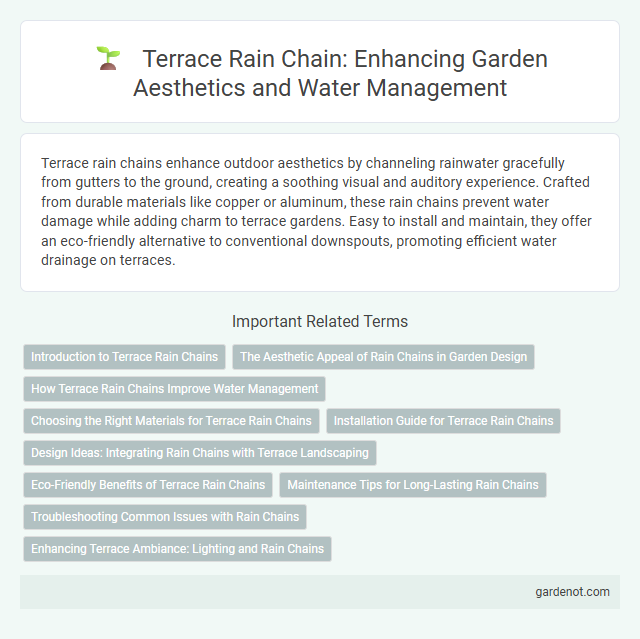Terrace rain chains enhance outdoor aesthetics by channeling rainwater gracefully from gutters to the ground, creating a soothing visual and auditory experience. Crafted from durable materials like copper or aluminum, these rain chains prevent water damage while adding charm to terrace gardens. Easy to install and maintain, they offer an eco-friendly alternative to conventional downspouts, promoting efficient water drainage on terraces.
Introduction to Terrace Rain Chains
Terrace rain chains are decorative alternatives to traditional downspouts, designed to guide rainwater from rooftops to the ground or drainage systems efficiently. Made from materials such as copper, aluminum, or stainless steel, they add aesthetic appeal while reducing water splashing and erosion around terraces. These rain chains enhance water flow visualization and complement outdoor architecture, making them popular in landscape design.
The Aesthetic Appeal of Rain Chains in Garden Design
Terrace rain chains enhance garden design by adding a visually captivating water feature that replaces traditional downspouts with elegant, cascading links. Their artistic appeal integrates seamlessly with natural surroundings, creating soothing sounds and a dynamic focal point that complements various landscaping styles. Incorporating copper or brass materials intensifies the aesthetic, as these metals develop a beautiful patina over time, enriching the garden's overall ambiance.
How Terrace Rain Chains Improve Water Management
Terrace rain chains enhance water management by guiding rainwater down multiple levels, reducing soil erosion and preventing water pooling on terraces. Their design slows the flow of water, promoting better absorption into the ground and minimizing runoff. This natural redirection of water supports sustainable landscaping and protects structural integrity of terrace surfaces.
Choosing the Right Materials for Terrace Rain Chains
Terrace rain chains are most effective when crafted from durable, weather-resistant materials such as copper, stainless steel, or aluminum, which resist corrosion and withstand heavy rain. Copper rain chains develop a unique patina over time, adding aesthetic value and protecting the metal from environmental damage. Selecting materials with proper weight ensures the rain chain maintains its shape and function, preventing deformation during high winds or water flow.
Installation Guide for Terrace Rain Chains
Terrace rain chains can be easily installed by replacing traditional downspouts with a decorative chain that guides rainwater from the terrace roof to the ground or a drainage system. Secure the top of the rain chain to the existing gutter or downspout outlet using a suitable hook or bracket, ensuring stability against wind and water flow. Regularly check connections and clean the chain to maintain efficient water flow and prevent clogging from debris.
Design Ideas: Integrating Rain Chains with Terrace Landscaping
Terrace rain chains enhance landscape aesthetics while efficiently guiding water from gutters to ground or collection systems, combining function with design. Incorporating copper or brass rain chains alongside stone pathways and potted plants creates a harmonious, calming water feature that complements natural terrace materials. Positioning rain chains near seating areas or garden beds leverages both sound and visual appeal, making rainwater management an integral part of terrace landscaping.
Eco-Friendly Benefits of Terrace Rain Chains
Terrace rain chains provide an eco-friendly alternative to traditional downspouts by naturally directing rainwater to gardens or storage containers, reducing soil erosion and water runoff. Their design promotes rainwater harvesting, which conserves water and supports sustainable landscaping practices. Made from recyclable materials like copper or aluminum, terrace rain chains also contribute to environmental conservation by minimizing plastic use.
Maintenance Tips for Long-Lasting Rain Chains
To ensure the longevity of terrace rain chains, regularly clean debris and leaves from the links and drainage areas to prevent clogs and water damage. Inspect the chains for rust or corrosion, especially if made of metal, and apply a protective sealant or replace damaged sections as needed. Securely anchor the rain chain to both the gutter and ground to maintain stability during strong winds and heavy rainfall.
Troubleshooting Common Issues with Rain Chains
Terrace rain chains often face common issues such as clogging from leaves, misalignment causing improper water flow, and damage from strong winds. Regular cleaning and proper installation with secure mounting can prevent these problems and maintain efficient water drainage. Inspecting rain chains seasonally helps identify rust, cracks, or loose links to ensure long-lasting functionality.
Enhancing Terrace Ambiance: Lighting and Rain Chains
Terrace rain chains enhance outdoor ambiance by combining the soothing sound of flowing water with elegant visual appeal, especially when paired with strategically placed lighting. Installing LED lights along the rain chain accentuates the water's movement, creating a captivating nighttime feature that complements garden aesthetics. This fusion of illumination and water flow transforms terraces into tranquil, visually striking spaces.
Terrace rain chain Infographic

 gardenot.com
gardenot.com